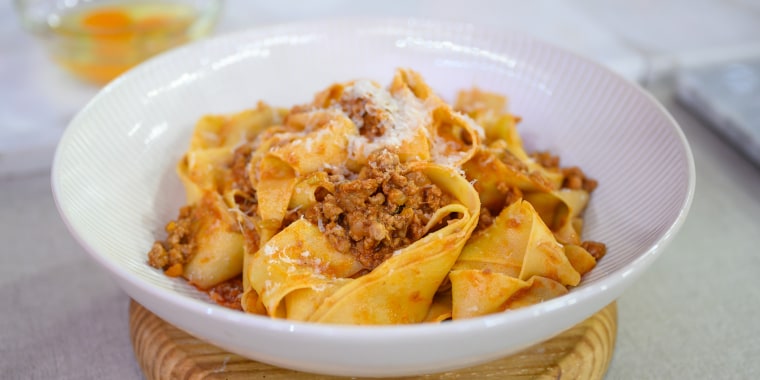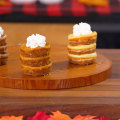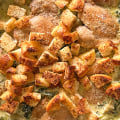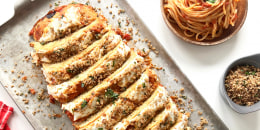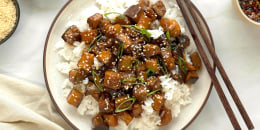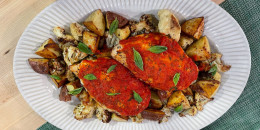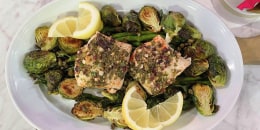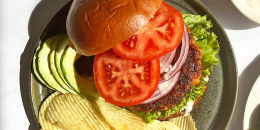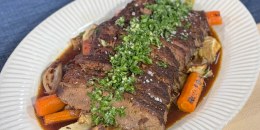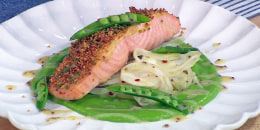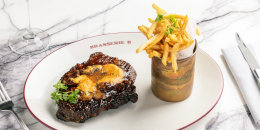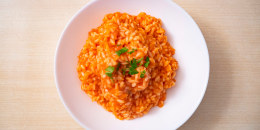Chef notes
All autumn long, wild boar recipes, especially those featuring long braises and hearty sauces, appear on menus all over Italy. Boar dishes aren't nearly as common in America, although you can buy wild boar meat from gourmet food purveyors and online (it's usually frozen). As it generally lacks the intense gaminess of its Italian counterpart, I compensate for this flavor deficit by using a robust herb bouquet.
Technique tip: I recommend grinding the boar, pancetta and vegetables using a meat grinder or the accompanying grinder attachment for your stand mixer. If you don't have either, simply cut the boar into 1-inch cubes and dice the pancetta into 1/4-inch batons. The sauce will keep, refrigerated in an airtight container, for up to 5 days, or frozen for up to 6 months.
Swap option: If you don't have a meat grinder, ask your butcher to grind it for you. Pork shoulder can be substituted for the boar. You can also use store-bought fresh pappardelle, tomato sauce and chicken broth if you don't have time to make your own.
Ingredients
- 10 pounds canned whole tomatoes
- 1/4 cup extra virgin olive oil
- 1 clove garlic, smashed
- 3 sprigs marjoram
- 1 tablespoon kosher salt
- 1 3½-pound whole chicken (preferably organic), rinsed and patted dry
- 1 1-pound veal or beef shank
- 2 celery stalks
- 1 large carrot
- 1 large yellow onion, halved
- 6 quarts cold water
- 1 pound "00" flour, plus more for dusting
- 9 1/10 ounces eggs, beaten
- 1 recipe sfoglia all'uovo (recipe above), at room temperature
- "00" flour, for dusting
- 3 pounds wild boar shoulder, or pork shoulder
- 5 ounces pancetta
- 4 celery stalks, roughly chopped
- 1 large yellow onion, roughly chopped
- 1 carrot, roughly chopped
- 1 small fennel bulb, outer layer discarded, roughly chopped
- 5 ounces strutto (lard)
- 6-8 fresh sage leaves, torn
- 5 juniper berries
- 2 cloves garlic, minced
- 1 sprig rosemary, picked and chopped
- 1 bay leaf, preferably fresh
- Kosher salt
- Freshly ground black pepper
- 1½ cups dry red wine
- 3 cups passata di pomodoro (recipe above)
- 2 cups brodo di carne (recipe above), or low-sodium chicken broth
- 2 tablespoons unsalted butter
- 1 recipe pappardelle (recipe above)
- 1/2 cup finely grated Parmigiano-Reggiano
Preparation
For the passata di pomodoro:
Pass the tomatoes through a food mill into a large bowl. Alternatively, in the bowl of a food processor, pulse the tomatoes on high speed until very smooth, about 1 minute.
In a large pot over medium-low heat, heat the oil until it begins to shimmer. Add the garlic and marjoram and cook until fragrant, about 1 minute. Add the tomatoes and salt and cook until the tomatoes have lost their raw flavor and the sauce has reduced slightly, about 30 minutes.
For the brodo di carne:
1.In a large heavy-bottomed pot over low heat, combine the chicken, veal shank, celery, carrot and onion.
2.Add the water and bring to a simmer. Decrease the heat as needed to maintain a bare simmer and cook, uncovered, for about 24 hours. The brodo can bubble occasionally, but do not boil, stir, or disturb it in any way.
3.After 24 hours, the brodo will be golden and translucent and taste savory. Using a ladle, skim off the scum from the top of the brodo and discard. One ladleful at a time, pass the brodo through a fi ne-mesh strainer or chinois into a large container or several smaller ones. Do not pour it — the force will push impurities through the strainer and contaminate the brodo.
4.Reserve the meats (discarding the bones) and vegetables (they will keep, refrigerated in an airtight container, for up to 3 days) for another use.
5.If you are not using the brodo now, cool it completely over an ice bath before storing. The brodo will keep, refrigerated in an airtight container, for up to 10 days or frozen for up to 3 months.
For the sfoglia all'uovo:
1.Sift the flour onto your work surface and make an 8-inch diameter well in the center. You should be able to see the work surface in the middle and the well's walls should be high enough to contain the eggs.
2.Pour the eggs into the well. Working from the interior edge of the well, use a fork to incorporate a bit of the flour with the eggs. Continue incorporating a bit of flour at a time until the dough is the consistency of pancake batter.
3.Clean off any flour mixture stuck to the fork and add it to the dough. Using a bench scraper, scrape any remaining flour from the work surface into the dough.
4.Working in a clockwise motion, cut the dough together as though you are making biscuits: scrape, fold and cut. Continue working the dough until a shaggy mass forms, 2-3 minutes. Parts of the mass will be rather wet, while other parts will be floury. Scrape any dough from the bench scraper into the mass.
5.With both hands, pull the far end of the dough toward you quickly and energetically, fold it over itself, then push it away from you using the heels of your palms. Rotate the dough a quarter turn and repeat the kneading for 3 to 5 minutes until the dough is a compact mass. The dough will be slightly tacky.
6.Using the bench scraper, scrape any dry bits of dough from your work surface and discard. Wash, but do not dry, your hands and continue kneading the dough as before until it is relatively smooth with a cellulite like texture, an indication of gluten formation, 3 to 5 minutes more.
7.Wrap the dough tightly in plastic wrap, seam-side up and smooth out any air pockets. Set aside to rest at room temperature for 15 minutes.
8.Unwrap the dough. Halve it with a sharp knife, cutting in a sawing motion.
9.On a lightly floured surface, knead one piece of dough energetically with both hands, anchoring the dough with your non-dominant hand as you pull the far end of the dough toward you, then press down, through and away, with your dominant hand. Turn the dough counterclockwise using your non dominant hand, moving it as you knead in 1- to 2-inch increments, like the hour markings on a clock.
10.If the dough feels too dry, spray it and your hands with water, a little at a time, until it loses its dryness.
11.If you are closing the round ball and find the folded end (or back door) is not sealing, spray that with a touch of water to help it along. Continue kneading until the dough is soft and smooth all the way around, 3-5 minutes. Repeat with the second piece of dough.
12.Place each dough ball in the middle of its own piece of plastic wrap measuring about 12-inch square.
13.Working with one ball at a time, pull one corner of the plastic wrap up and lay it over the ball. Then, turning and rotating as you go, make 15 to 20 tiny pleated folds of plastic, almost like a candy wrapper, until the ball is fully and tightly sealed. The plastic wrap will follow the contour of the dough, which will create even pressure and support from all sides and prevent a flat surface or hard edge from developing when wrapping the dough. Set the dough balls aside to rest at room temperature for 2-3 hours or up to 24 hours in the refrigerator before rolling.
14.The dough will keep, refrigerated and tightly wrapped in plastic wrap, for up to 2 days. Do not freeze it.
15.Before rolling, set the wrapped dough on the counter and let it come to room temperature, about 30 minutes. This is a must for refrigerated egg doughs.
For the pappardelle:
1.Roll one dough ball to a thickness of 9 Post-it® Notes on a lightly floured work surface. Cure the sfoglia.
2.Fold the sfoglia in half, press gently along the crease and unfold. Using a sharp knife, cut the sfoglia along the crease. Position the half-moon–shaped pieces of sfoglia with the round ends closest to you and the cut ends facing away from you. Starting at the round edge of one sfoglia crescent, fold the pasta 3 inches over and continue to fold until you have a loose roll. Repeat with the second crescent.
3.Beginning at the end of one roll, using a sharp knife, square off the edge and add these irregular pieces to your maltagliati pile. Continue cutting the sfoglia crosswise into 1 in [2.5 cm] thick strips, adding the irregular rounded pieces from the other end of the roll to your maltagliati pile. Repeat with the remaining crescent.
4.Take the pasta strand from the center of one roll, unfurl and place it on the work surface in a horizontal orientation. Working from the center outward, take the next pasta strand, unfurl and lay it on the work surface in a horizontal orientation. Repeat with 2 more strands to create a total of 4 stacks. Move the remaining strips together.
5.Take the pasta strand from the center of the second roll, unfurl and place it on the work surface in a horizontal orientation. Working from the center outward, take the next pasta strand, unfurl and lay it on the work surface in a horizontal orientation. Repeat with 2 more strands. Move the remaining cut rolled pasta together.
6.Working from the center outward, repeat the unfurling and stacking process until no rolled pasta remains.
7.Using one hand, grasp the center of the first stack and let the strands hang. Fold the stack in half and transfer it to a clean work surface, cut side up. Repeat with the remaining stacks. Use now or refrigerate, in a high-sided container lined with paper towels and loosely covered, for up to 24 hours.
8.Meanwhile, repeat the process with the remaining dough ball. To cook, unfurl the pasta rolls onto a tray before dropping them into salted boiling water.
For the ragù:
1.Using a meat grinder, or a grinder attachment, fitted with a large die, grind the boar shoulder into a large bowl (see tip). Set aside. Without cleaning the grinder, grind the pancetta into a small bowl and set aside.
2.Pass the celery, onions, carrots and fennel through the grinder into a medium bowl and set aside.
3.In a large heavy-bottomed pot over medium-high heat, melt the strutto. Add the ground pancetta. Cook until the fat has rendered, about 4 minutes. Add the sage, juniper berries, garlic, rosemary and bay leaf. Cook until fragrant, about 30 seconds. Add the ground vegetables. Cook, stirring frequently, until golden brown and softened, about 15 minutes.
4.Add the ground boar and generously season with salt and a small amount of pepper. Using a wooden spoon, gently mix the meat and vegetables, stirring from the bottom of the pot. Cook until the meat releases its juices, 6-8 minutes. Stir in the wine. Cook until the contents of the pan begin to steam. Stir in the passata and brodo, turn the heat to low and cook, stirring occasionally, until the meat is fork- tender, 3-5 hours. Begin tasting for tenderness and seasoning after 3 hours.
5.Transfer 5 cups of the sauce to a large pot over medium heat. (Store the extra sauce according to the instructions following.) Bring the sauce to a rapid simmer and cook until the sauce reduces slightly, about 3-4 minutes. Add the butter and swirl to emulsify. Set the sauce aside.
6.Bring a large pot of water to a rolling boil over high heat. Season the water with salt. When the salt dissolves, unfurl the pappardelle rolls onto a tray. Gather the strands and, working quickly in batches, drop them into the boiling water. Stir to separate the strands and cook until tender, 1-2 minutes.
7.Meanwhile, return the sauce to medium heat. Using tongs, transfer the pasta to the sauce and toss to coat. Add some pasta cooking water, as needed, to loosen the sauce. Serve immediately with the Parmigiano-Reggiano sprinkled on top.
Reprinted from American Sfoglino by Evan Funke with permission by Chronicle Books, © 2019.
TODAY has affiliate relationships, so we may get a small share of the revenue from your purchases. Items are sold by the retailer, not by TODAY.
